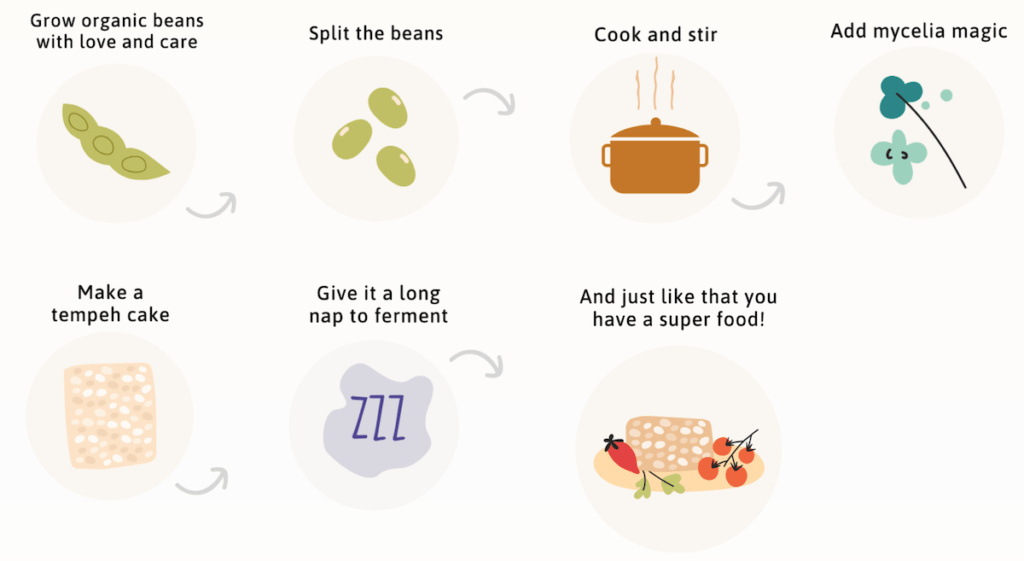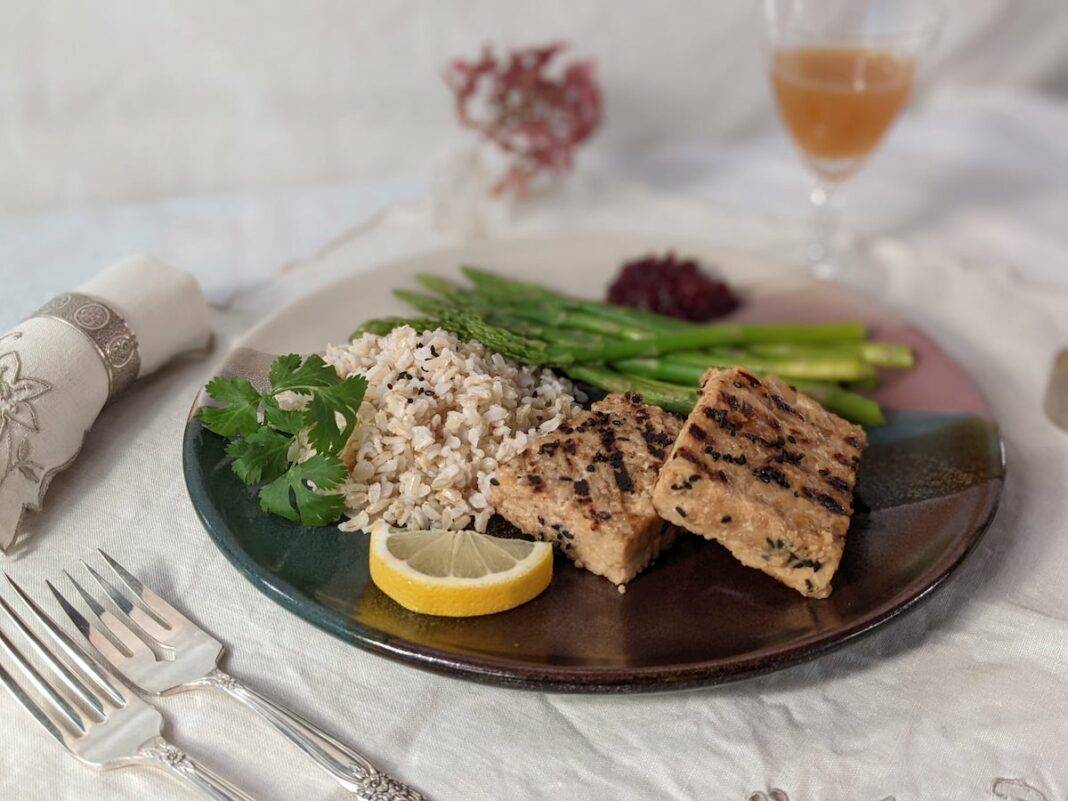Tootie’s Tempeh, based in Maine, has made the ancient staple irresistible.
Tempeh, a fermented soy protein, hits all the right notes for a healthier, convenient alternative to meat:
- It’s plant-based and vegan, made from real soybeans, and not highly processed or made in a lab.
- It’s a convenient, ready-to-eat food.
- It’s sustainably made and good for the planet.
But for me, at least, there was always one drawback: I didn’t really like it. Friends I’ve talked to and people I’ve cooked for didn’t much like tempeh, either. That is until recently, when I tried Tootie’s Tempeh, made by a new worker-owned cooperative in Maine using local soybeans and a reconfigured process to make a fresher product. Now, I can’t stop eating it — and thinking of ways to enjoy it in recipes.
Tempeh is an ancient, fermented staple of both Indonesia and Malaysia, where it was traditionally made from boiled soybeans and fermented in banana leaves to create a dense protein cake. Its more popular cousin, tofu, also made from soybeans, originates in China but is made without a fermenting process, resulting in softer, spongier blocks of protein. Tempeh’s denseness gives it nearly double the amount of protein found in tofu, about 16 grams per 3-ounce serving (about 1/2 cup), compared to 8 to 10 grams for the same quantity of tofu. Tempeh has loads of calcium, iron, and fiber, and zero cholesterol as well.

Traditionally made tempeh has a nutty flavor, but today’s commercially made tempeh sometimes has a slightly bitter or sour taste. Aware that commercial producers use plastic bags to ferment their culture-innoculated beans, in 2019, Tootie’s Tempeh founders Sarah Speare and Barbara Fiore wondered whether there might be a better way to make tempeh, one that would be more in line with their values as environmentalists and closer to tempeh’s traditional origins. Three years and three workspaces later, after lots of experimentation, grants, and grit, they formulated a tempeh inoculated with mycelia and fermented in metal pans, not plastic bags. Made from organic soybeans grown in Northern Maine, the resulting product has a smoother, better flavor than any other tempeh I’ve tried, and it crumbles more easily, enabling it to soak up whatever flavors it’s cooked or paired with.
Why don’t more people know about this incredible superfood that is so high in protein, so clean, and a simply made whole food that is sustainable and plant-based and fermented?
– Sarah Speare, co-founder Tootie’s Tempeh
“Some people say our tempeh tastes creamy and buttery,” says Speare, Tootie’s CEO. The flavor of tempeh is a bit hard to nail down in general, she says. “A lot of people say it has a nutty, umami flavor. It’s sort of mushroomy and nutty. It’s not rubbery like tofu. It’s got a real texture to it, more like meat, I guess.”
Tootie’s Tempeh is now comfortably housed in Biddeford, in a 2,000-square-foot space in the historic Pepperell Mill, a complex that was once home to sixteen mills producing textiles and blankets. One of the restaurants nearby, Vickie’s Veggie Table, uses Tootie’s tempeh “bacon” for their “BLTs,” along with avocado, tomato, and a chipotle cashew cream. The sourdough bread for the sandwich comes from Little Spruce Baking Co., a wholesale bread business also located in the Biddeford mill complex. Speare says the town of Biddeford, bustling with restaurants and breweries, was recently rated as one of the top foodie towns in the country. “It’s sort of like Portland, ten years ago,” she notes.
Speare says she is happy not only with the flavor of their tempeh, but also with its environmental benefits. Tempeh in general uses a fraction of the water required by animal proteins, and it produces dramatically less CO2. Speare is quick to say they are the first and only US tempeh maker to not ferment in plastic bags. When packaged, the tempeh is vacuum-sealed in a single plastic wrapper for freshness and extended shelf-life, but they hope to introduce recyclable or plant-based bags in the future. The idea for this business, she said, came to her one day practically as a download — she wrote everything on a piece of paper, including the name “Tootie’s”, in honor of her late mother, who was a bit of a rebel, an environmentalist, and an early supporter of Rachel Carson. Speare previously co-founded a successful pet food company called Chomp, and she served as Executive Director at the Institute for Humane Education for eight years, focusing on global ethical issues related to sustainability, social justice, and animal protection. She is joined in the business now with two other employees, including Michael LaCharite, a former Maine brewmaster, who now heads the fermenting process and production. (Her former partner, Barbara Fiore, has moved on to other endeavors.)
Tootie’s primary source of soybeans from Aurora Mills and Farm, a 400-acre organic and regenerative farm in Aroostook County, run by first- and second-generation father and daughter farmers. They grow wheat, oats, and barley, some shipping to Maine’s large craft beer brewing community, as well as to Maine bakeries. The soybeans grow as a cover crop, building a healthy soil for the other grains. “The beautiful thing is, our beans are nourishing all the oats and grains for so many breadmakers and beermakers,” Speare points out. “Our beans are nourishing all those grains. I just get chills thinking about that.”
Speare calls tempeh a “sleeping giant,” and wonders why, as a plant-based food, it has not soared more in popularity. “Why don’t more people know about this incredible super food that is so high in protein, so clean, and a simply made whole food that is sustainable and plant-based and fermented?”
Tootie’s Tempeh will be working on that. You can find their tempeh throughout Maine and New England, with store locations listed on their website, along with tempeh recipes. Tootie’s comes in a snappy purple and green cardboard box and is located in the refrigerated section.
Ways to Cook With Tempeh
Tempeh is versatile and can be sauteed, grilled, stuffed into things, or formed into balls. It absorbs flavors and cooks similarly to meat. Some people prefer to steam it for a few minutes before grilling to help it absorb marinades. Here are some ideas for using tempeh:
- Crumbled and sautéed for tacos, bolognese, chili, shepherd’s pie, and stuffed peppers.
- Cubed and pan seared for stir frys, bowls, and salad “croutons.”
- Cut into chunks and skewered with veggies (zucchini, peppers, red onions, mushrooms etc) for the grill or broiler, with BBQ sauce or marinade.
- Cut into strips or thickly sliced rectangles and pan seared for BLT’s, Reubens and other veggie sandwiches.
Benefits of Eating Tempeh
- It’s a prebiotic and is good for you. Friendly fiber feeds beneficial bacteria in your belly.
- It’s rich in calcium, protein and antioxidants.
- Growing soybeans creates fertile, nitrogen-rich soil.
- It’s gentle on the planet, requiring much less water and energy to produce than other protein-rich foods.
Do you want to help start a Tootie’s Tempeh revolution and get into the plant-based food business? Then Tootie’s wants you.
As a worker-owned cooperative, based on sustainability and a regional economy, they don’t want to fly or truck their product across the country — then it wouldn’t be local or sustainable. Their strategy is to open franchises of tempeh cooperatives across the US — each one sourcing from their own local farmers and distributing locally in their own region.
When founders Speare and Fiore started the company in 2019, they had their own strict set of sustainable strategies in mind.
“We already knew what our values were,” says Speare. “Our values are to support the wellness of people, animals, and the planet, and that guides literally everything we do. That is why we source locally. We try to get everything right nearby, supporting our community and our region. We’re the most sustainable tempeh in the country, and I think that’s what makes our tempeh better.”
But first the pair had to come up with a better-made tempeh, not fermented in plastic as most tempeh is today. That was not easy. In Java, Indonesia, tempeh was traditionally made from boiled soybeans and wrapped in the product at hand, banana leaves, to ferment. Speare and company tried some of New England’s materials, fermenting the tempeh first in seaweed, then corn husks, even grape leaves. None of those encasements worked the way they’d hoped, because fermenting tempeh needs strictly controlled temperatures, humidity, and airflow. Eventually they settled on metal pans, in a controlled environment, powered in part by the Pepperell Mill's solar panels. “We do it in metal pans, with the right sized holes for the oxygen to get through. It has to breathe. That’s what took so long… three years. But we had great industry partners in it, we had lots of support, we had grants from the Maine Technology Institute. We were really doing a technical innovation which is actually proprietary and patentable. We have already saved thousands of plastic bags from landfills and oceans.”
Tootie’s tempeh is now being sold around New England and is winning raves from chefs and vegans throughout the region. Now Tootie’s is hoping for partners around the country.
One of the company’s fans is Karina Hines, founder of Botanical Kitchen in Portland, Maine, and a Bluedot Living recipe contributor. “I have been a plant-focused chef for decades,” she says, “and Tootie’s is by far the best tempeh I have ever experienced.” Try her recipe for Tempeh Vegetable Stir-fry with Ginger Soy Sauce and Catherine Walthers' recipe for Tempeh Tacos.


